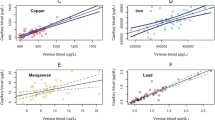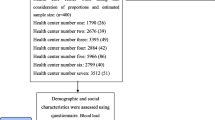Abstract
Our study aimed at comparing lead and zinc protoporphyrin (ZPP) levels in capillary and venous blood samples in a small population and to employ an easier method of sample collection for a major screening program in school children in major Indian cities. An awareness program on lead and its effects was conducted in two different schools. A total of thirty urban school children from South India, with an age group between 4–12 years consented for dual blood sampling and reported for the study. Venous and capillary blood samples were obtained simultaneously. Blood lead and zinc protoporphyrin (ZPP) levels were estimated using ESA Lead Analyzer and Haematofluorometer respectively. A significant correlation between capillary and venous ZPP (r=0.98) and lead (r=0.99) was observed. Rank sum test showed that there is no statistically significant difference between capillary and venous ZPP (P=0.891) and lead (P=0.672) values. This pilot study recommends that screening for lead may be done using capillary blood samples since significant correlation is observed between capillary and venous blood measurements. Obtaining samples using this mode is a non-invasive, less expensive, quick and easy method in children. Appropriately performed capillary sampling may be considered as an acceptable alternative to venipuncture for screening of blood for lead poisoning both in children and adults.
Similar content being viewed by others
References
Lalit, B.Y., Ramachandran, T.V. and Rajan, S. (1980) Lead-210 content of food samples in India. Radiation and Environmental Biophysics 18(1), 13–17.
Khandekar, R.N., Raghunath, R. and Mishra, U.C. (1987) Levels of lead, cadmium, zinc and copper in the blood of an urban population. The Science of the total environment. 66, 185–191.
Potula, V. and Hu, H. (1996) Occupational and lifestyle determinants of blood lead levels among men in Chennai, India. International Journal of Occupational and environmental health. 2(1), 1–4.
Keen, R.W., Deacon, A.C., Delves, H.T., Moreton, J.A. and Frost, P.G. (1994) Indian herbal remedies for diabetes as a cause of lead poisoning. Postgrad. Med. J. 70, 113–114.
Srikanth, R., Ramana, D. and Rao, V. (1995) Role of rice and cereal products in dietary cadmium and lead intake among different socio-economic groups in south India. Food additives and contamination. 12(5), 695–701.
Shenoi, R.P., Khandekar, R.N., Jayakar, A.V. and Raghunath, R. (1991) Sources of lead exposure in urban slum school children. Indian Pediatrics. 28, 1021–1027.
CDC (Centers for Disease Control). (1991) Preventing lead poisoning in young children: A statement by the centers for Disease Control-October 1991. CDC, U.S. Department of Health and Human Services Publication. Atlanta, GA.
McElvine, M.D., Orbach, H.G., Binder, S., Blanksma, L.A., Maes, E.F. and Krieg, R.M. (1991) Evaluation of the erythrocyte protoporphyrin test as a screen for elevated blood lead levels. J. Pediatr. 119, 548–550.
Edwards, K.S. and Forsyth, B.W.C. (1989) Lead screening at pediatric teaching programs. Am. J. Dis. Child. 143, 1455–1457.
DeSilva, P.E. and Donnan, M.B. (1980) Blood lead levels in Victorian children. Med. J. Aust. 1, 93–96.
Lyngbye, T., Jorgensen, P.J., Granjean, P. and Hansen, O.N (1990) Validity and interpretation of blood lead levels: a study of Danish school children. Scan. J. Clin. lab. Invest. 50, 441–449.
Carl, A.B. and Edward, R.A. (1999), Tietz Textbook of Clinical Chemistry. 3rd edn. W.B. Saunders, U.S.A. p 1033.
Blumberg, W.E., Eisinger, J., Lamola, A.A. and Zuckerman, D.M (1977) The Haematofluorometer. Clin. Chem. 23, 270–274.
Roda, S.M., Greenland, R.D., Bornschein, R.L. and Hammond, P.B. (1988) Anodic Stripping Voltammetry procedure modified for improved accuracy of blood lead analysis. Clin. Chem. 34, 563–567.
Author information
Authors and Affiliations
Corresponding author
Rights and permissions
About this article
Cite this article
D'Souza, H.S., Menezes, G. & Venkatesh, T. Screening for lead poisoning in urban school children of southern India using capillary and venous blood samples. Indian J Clin Biochem 17, 1–4 (2002). https://doi.org/10.1007/BF02867932
Issue Date:
DOI: https://doi.org/10.1007/BF02867932




